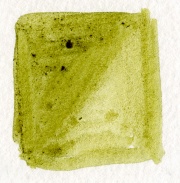Sap green
Jump to navigation
Jump to search
Description
An obsolete lake pigment made from the juice of Buckthorn berries (primarily Rhamnus catharticus), mordanted on Alum. Sap green is produced by adding an alkali (soda or lime) to the purple red juice, pressed from the ripe berries. The dark, yellowish green color was then mixed with alum and gum to form a thick syrup that was placed in pig bladders, hence received the name bladder green. Sap green was used in watercolor paints in the 17th and 18th centuries. The primary colorant in R.catharticus is kaempferol, but berries from other buckthorn plants may contain Rhamnetin or Quercetin.
Synonyms and Related Terms
bladder green; iris green; verd vessie; vert de Vessie; Saftgrün (Deut.); sucus
Physical and Chemical Properties
Sap green has poor lightfastness.
Resources and Citations
- R. J. Gettens, G.L. Stout, Painting Materials, A Short Encyclopaedia, Dover Publications, New York, 1966
- Ralph Mayer, A Dictionary of Art Terms and Techniques, Harper and Row Publishers, New York, 1969 (also 1945 printing)
- R.D. Harley, Artists' Pigments c. 1600-1835, Butterworth Scientific, London, 1982
- Art and Architecture Thesaurus Online, http://www.getty.edu/research/tools/vocabulary/aat/, J. Paul Getty Trust, Los Angeles, 2000
- F. Crace-Calvert, Dyeing and Calico Printing, Palmer & Howe, London, 1876
- The Dictionary of Art, Grove's Dictionaries Inc., New York, 1996 Comment: 'Pigments'
- Judith Hofenk-de Graaff, Natural Dyestuffs: Origin, Chemical Constitution, Identification, Central Research Laboratory for Objects of Art and Science, Amsterdam, 1969
- Book and Paper Group, Paper Conservation Catalog, AIC, 1984, 1989
